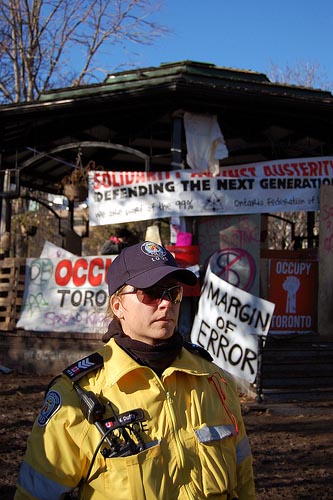I have to admit it, I had preconceived notions about Occupy Toronto.
I made assumptions about who would be taking part, how they would be engaging in dialogue and what sort of topics would be central to these discussions.
Whenever possible, I had participated in large scale acts of resistance. I was surrounded by police officers for five hours while I attended the G8 protests in London. I witnessed the showdown between the riot police and protestors during the G20 protests in Toronto. However, the ongoing existence of the Occupy Toronto movement diminished any need for immediate participation. Instead, I told myself, I would eventually visit St. James Park, the location of the tent city that was the basis of the occupy movement.
Then I read an email proclaiming that tent dwelling participants of Occupy Toronto had received eviction notices, commencing at midnight. The urgency arose, as it seemed it was now or never. I had to go see the Occupy Toronto site before it followed in the image of Occupy Wall Street. I grabbed my camera and with my assumptions in tow, headed to St. James Park.
The first site I stumbled upon was at the entrance of the encampment and was one I was familiar with. It was a circle of people involved in a participatory decision-making process. As I had seen through various news clips, a facilitator would call on a participant to speak, the speaker would voice their opinion while the rest of the circle of individuals would repeat the speaker’s words. On screen this process was rather irritating, in person it was invigorating.
As I approached the circle, a middle-aged man, who appeared to have spent the past few weeks devoted to the Occupy movement, turned around and offered myself and the surrounding individuals food from a Tupperware container. I politely declined but that simple act allowed my guard to be lowered. I began to wonder if my assumptions were unfounded.
The decision in question was regarding how to approach the impeding eviction notice. There was a debate brewing about the suggestion of a midnight dance party. I scoffed a tad at the protester dance party cliché, but then I began to listen to the participants as they attempted to reach a decision. Well articulated arguments emerged from both sides:
• Playing loud intrusive music would give the police a justification to forcibly remove protesters;
• Art and more specifically dance is considered a form of cultural resistance, participating in these art forms would illustrate non-conformity to the system they were all trying to challenge;
• Having a dance party would allow media sources to frame the eviction as the fault of the protesters.
The debate went on and I witnessed a form of decision-making I had never seen before. Raw participatory decision-making. While the topic of debate may seem redundant to some, the process in which anyone could join and contribute to the decision-making was moving. As I stood in the circle listening to the different sides of the debate I even found myself repeating the words of the speaker. It was that easy to join the movement, to feel like a contributor and it felt good.
After the dance party was squashed through a group vote, I was off to explore the sprawling tent city that had engulfed St. James Park. My assumptions were that a few tents would be scattered throughout the park. I was very wrong. A mini village had been constructed in the park. There were dozens of tents, all home to Occupy protesters, many guarded with carefully crafted signs proclaiming various grievances pertaining to the current economic and political system. There was a free food tent, a free store, an art display section, a large sign-making section, a yoga yurt, a library yurt, and a sacred fire.
I was amazed by the sophistication of this microcosm and ashamed that I had perhaps almost missed the chance to witness the movement. People were generally friendly and welcoming. Food was being offered generously. I was approached by a woman asking if I wanted to “show my solidarity by eating a Timbit?” As I ate my solidarity Timbit, I saw two young protesters joking with journalists about how they actually were the 1 per cent.The journalists were jovial as they interacted with the young protesters, as were the firemen, city workers and police officers that I saw.
Midnight, came and went with a court injunction allowing the protesters to remain in St. James Park. However, On Nov. 15 Justice David Brown ruled the eviction notice was constitutionally valid. The last traces of occupiers’ tents were taken down on November 23rd. Protesters are currently deciding how to continue the movement.
Whether the protesters decide to occupy another location such as Queen’s Park or to continue the movement through online tools, I feel privileged to have seen the Occupy Toronto protest for myself and have been aptly reminded that when possible to experience highly mediated events for yourself. More importantly, I am reminded that there is no single method of action or knowing, and to keep yourself open to new possibilities. Occupy Toronto, I must graciously apologize and thank you for greatly exceeding my assumptions.
Lisa Rideout is currently enrolled in the MFA Documentary Media program at Ryerson University. She is the Director of Communication and Outreach at Good Evidence, a Toronto based non-profit organization that creates short documentaries to challenge conventional representations of development.




